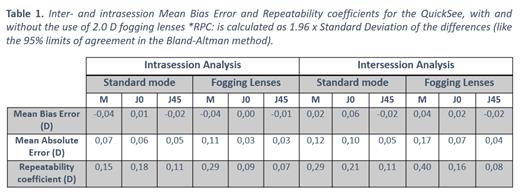Inter- and intrasession reproducibility of an open-field portable wavefront autorefractor with and without fogging lenses

| AUTHORS | |
| JOURNAL | ARVO |
| ABSTRACT |
PurposeHigh repeatability portable autorefractors may enable effective deploy of global-health initiatives to mitigate uncorrected refractive error worldwide. For example, in studies to evaluate the effectiveness of different measures, repeatability has a direct impact on the statistical power and sample size required, while in screening applications, contributes to increased sensitivity and specificity. This work presents a preliminary assessment of the inter- and intrasession repeatability of an affordable autorefractor (QuickSee, PlenOptika Inc) under two separate measurement conditions, with and without fogging lenses. Methods6 volunteers (29,8 ± 8,1 years old) were measured at 2 different sessions spaced 1-week. Each subject was tested 6 times per session with the QuickSee, 3 times in standard mode and 3 using a modified version of the device eyecup to allow over-refraction through fogging lenses (+2.0 D). Intersession measurements were spaced 5 minutes apart and the complete alignment procedure was repeated for each measurement. After converting autorefractor readings into power vectors (M, J0, J45), repeatability was evaluated using the Bland-Altman method to compare differences between all possible combinations from each subject (inter- and intrasession). Repeatability coefficients (RPC), estimated as the 95% limits of agreement, and the mean absolute errors were also evaluated. In all cases, only results for the right eyes were analyzed. ResultsParticipants had an average Spherical Equivalent (SE) refraction of -0.75 ± 2.06 D, (Min -5.11 D, Max 0.175 D). A total of 36 samples per dataset were obtained for the intrasession analysis while 54 samples per dataset were used in the intersession comparison. In all cases the mean difference was practically 0 indicating no bias for any of the vector components. SE RPCs for intrasession test were 0.15 D in standard mode and 0.29 D with the fogging lenses. Intersession RPCs were 0.29 D and 0.4 D without and with the fogging lenses, respectively. Detailed results for all vector components are shown in Table 1. ConclusionsThis preliminary analysis shows that the device can provide excellent RPCs in standard mode, which decrease moderately with the use of the fogging lenses. Further work exploring improvements in the eyecup design and measurement averaging techniques may further enhance the RPC values in over-refraction mode. |
| LINK | here |



